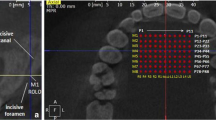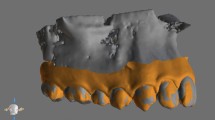Abstract
Temporary anchorage devices (TADs) are frequently applied to different anatomic areas with different protocols to increase skeletal effects and anchorage in orthodontic treatment planning. It has been reported in many literatures that primary stability for orthodontic TADs is significant for long-term survival rate. For this reason, different areas of the palatal region, which has many indications, have been widely used in the studies. In this evaluation where bone quality and thickness are important, density, bone thickness, and fractal dimension (FD) on cone beam computed tomography (CBCT) will provide more predictable clinical results. The aim of this study was to evaluate bone thickness, density, and FD in the palatal region of the first, and second premolars, and first molars. There was a remarkable difference (p < 0.05) between the parameters of FD, thickness and density of bone in the identified areas in the palatal region. In terms of thickness and FD, the 1st premolar region had significantly higher values than the other regions (p < 0.05). In terms of density, the values in the right 1st molar and right 1st premolar regions were significantly higher (p < 0.05). The 1st premolar region is an ideal site for placement of palatal TADs. CBCT-assisted preliminary evaluation of FD value, bone density, and thickness may increase clinical success when selecting the location of TADs to be applied to the palatal bone.


Similar content being viewed by others
Data availability
The datasets used and analyzed during the current study are available from the corresponding author on reasonable request.
Abbreviations
- CBCT:
-
Cone beam computed tomography
- DICOM:
-
Digital ımaging and communications in medicine
- FD:
-
Fractal dimension
- TADs:
-
Temporary anchorage devices
References
Ueno S, Motoyoshi M, Mayahara K, Saito Y, Akiyama Y, Son S, et al. Analysis of a force system for upper molar distalization using a trans-palatal arch and mini-implant: a finite element analysis study. Eur J Orthod. 2013;35(5):628–33.
Park CO, Sa’aed NL, Bayome M, Park JH, Kook YA, Park YS, et al. Comparison of treatment effects between the modified C-palatal plate and cervical pull headgear for total arch distalization in adults. Korean J Orthod. 2017;47(6):375–83.
Wehrbein H, Glatzmaier J, Mundwiller U, Diedrich P. Das Orthosystem—Ein neues Implantatsystem zur orthodontischen Verankerung am Gaumen. J Orofac Orthop/Fortschritte Kieferorthopädie. 1996;57(3):142–53.
Papadopoulos MA, Tarawneh F. The use of miniscrew implants for temporary skeletal anchorage in orthodontics: a comprehensive review. Oral Surg Oral Med Oral Pathol Oral Radiol Endod. 2007;103(5):e6-15.
Mizrahi E. The use of miniscrews in orthodontics: a review of selected clinical applications. Prim Dent J. 2016;5(4):20–7.
Kokitsawat S, Manosudprasit M, Godfrey K, Chatchaiwiwattana C. Clinical effects associated with miniscrews used as orthodontic anchorage. Aust Orthod J. 2008;24(2):134–9.
Kyung SH, Lee JY, Shin JW, Hong C, Dietz V, Gianelly AA. Distalization of the entire maxillary arch in an adult. Am J Orthod Dentofac Orthop. 2009;135(4 Suppl):123–32.
Kinzinger GSM, Eren M, Diedrich PR. Treatment effects of intraoral appliances with conventional anchorage designs for non-compliance maxillary molar distalization: a literature review. Eur J Orthod. 2008;30(6):558–71.
Ayadi I, Dallel I, Ben Rejeb S, Tobji S, Ben Amor F, Ben AA. Orthodontic intrusion using mini-screws. Orthod Francaise. 2018;89(4):397–410.
Becker K, Pliska A, Busch C, Wilmes B, Wolf M, Drescher D. Efficacy of orthodontic mini implants for en masse retraction in the maxilla: a systematic review and meta-analysis. Int J Implant Dent. 2018;4(1):35.
AlMaghlouth B, AlMubarak A, Almaghlouth I, AlKhalifah R, Alsadah A, Hassan A. Orthodontic ıntrusion using temporary anchorage devices compared to other orthodontic ıntrusion methods: a systematic review. Clin Cosmet Investig Dent. 2021;13:11–9.
Wilmes B, Rademacher C, Olthoff G, Drescher D. Parameters affecting primary stability of orthodontic mini-implants. J Orofac Orthop. 2006;67(3):162–74.
Ahn HW, Kang YG, Jeong HJ, Park YG. Palatal temporary skeletal anchorage devices (TSADs): What to know and how to do? Orthod Craniofac Res. 2021;24:66–74.
Topouzelis N, Tsaousoglou P. Clinical factors correlated with the success rate of miniscrews in orthodontic treatment. Int J Oral Sci. 2012;4(1):38–44.
Park HS, Jeong SH, Kwon OW. Factors affecting the clinical success of screw implants used as orthodontic anchorage. Am J Orthod Dentofac Orthop. 2006;130(1):18–25.
Moon CH, Lee DG, Lee HS, Im JS, Baek SH. Factors associated with the success rate of orthodontic miniscrews placed in the upper and lower posterior buccal region. Angle Orthod. 2008;78(1):101–6.
Männchen R, Schätzle M. Success rate of palatal orthodontic implants: a prospective longitudinal study. Clin Oral Implants Res. 2008;19(7):665–9.
Wehrbein H. Bone quality in the midpalate for temporary anchorage devices. Clin Oral Implants Res. 2009;20(1):45–9.
Gracco A, Lombardo L, Cozzani M, Siciliani G. Quantitative cone-beam computed tomography evaluation of palatal bone thickness for orthodontic miniscrew placement. Am J Orthod Dentofacial Orthop. 2008;134(3):361–9.
Ahn HW, Kang YG, Jeong HJ, Park YG. Palatal temporary skeletal anchorage devices (TSADs): What to know and how to do? Orthod Craniofac Res. 2021;24(1):66–74.
Miyawaki S, Koyama I, Inoue M, Mishima K, Sugahara T, Takano-Yamamoto T. Factors associated with the stability of titanium screws placed in the posterior region for orthodontic anchorage. Am J Orthod Dentofac Orthop. 2003;124(4):373–8.
Schnelle MA, Beck FM, Jaynes RM, Huja SS. A radiographic evaluation of the availability of bone for placement of miniscrews. Angle Orthod. 2004;74(6):832–7.
Bakopoulou A, Hoang P, Fathi A, Foley M, Dunstan C, Dalci O, et al. A comparative histomorphological and micro computed tomography study of the primary stability and the osseointegration of The Sydney Mini Screw; a qualitative pilot animal study in New Zealand rabbits. Eur J Orthod. 2019;41(4):360–9.
Kavitha MS, An SY, An CH, Huh KH, Yi WJ, Heo MS, et al. Texture analysis of mandibular cortical bone on digital dental panoramic radiographs for the diagnosis of osteoporosis in Korean women. Oral Surg Oral Med Oral Pathol Oral Radiol. 2015;119(3):346–56.
Zeytinoğlu M, İlhan B, Dündar N, Boyacioğlu H. Fractal analysis for the assessment of trabecular peri-implant alveolar bone using panoramic radiographs. Clin Oral Investig. 2015;19(2):519–24.
Chugh T, Jain AK, Jaiswal RK, Mehrotra P, Mehrotra R. Bone density and its importance in orthodontics. J Oral Biol Craniofacial Res. 2013;3(2):92–7.
Monje A, Ravidà A, Wang HL, Helms JA, Brunski JB. Relationship between primary/mechanical and secondary/biological ımplant stability. Int J Oral Maxillofac Implants. 2019;34:s7-23.
Baksi BG, Fidler A. Fractal analysis of periapical bone from lossy compressed radiographs: a comparison of two lossy compression methods. J Digit Imaging. 2011;24(6):993–8.
Andreotti AM, Goiato MC, Nobrega AS, Freitas da Silva EV, Filho HG, Pellizzer EP, et al. Relationship between ımplant stability measurements obtained by two different devices: a systematic review. J Periodontol. 2017;88(3):281–8.
White SC, Rudolph DJ. Alterations of the trabecular pattern of the jaws in patients with osteoporosis. Oral Surg Oral Med Oral Pathol Oral Radiol Endod. 1999;88(5):628–35.
Asscherickx K, Vannet BV, Bottenberg P, Wehrbein H, Sabzevar MM. Clinical observations and success rates of palatal implants. Am J Orthod Dentofac Orthop. 2010;137(1):114–22.
Kakali L, Alharbi M, Pandis N, Gkantidis N, Kloukos D. Success of palatal implants or mini-screws placed median or paramedian for the reinforcement of anchorage during orthodontic treatment: a systematic review. Eur J Orthod. 2019;41(1):9–20.
Rodriguez JC, Suarez F, Chan HL, Padial-Molina M, Wang HL. Implants for orthodontic anchorage: success rates and reasons of failures. Implant Dent. 2014;23(2):155–61.
Lee MY, Park JH, Kim SC, Kang KH, Cho JH, Cho JW, et al. Bone density effects on the success rate of orthodontic microimplants evaluated with cone-beam computed tomography. Am J Orthod Dentofac Orthop. 2016;149(2):217–24.
Cassetta M, Stefanelli LV, Pacifici A, Pacifici L, Barbato E. How accurate is CBCT in measuring bone density? A comparative CBCT-CT in vitro study. Clin Implant Dent Relat Res. 2014;16(4):471–8.
Rai S, Misra D, Misra A. Cone-beam computed tomography assessment of bone using grayscale values in patients with diabetes mellitus. A case-control observational study. J Indian Soc Periodontol. 2020;24(6):560–6.
Dahiya K, Kumar N, Bajaj P, Sharma A, Sikka R, Dahiya S. Qualitative assessment of reliability of cone-beam computed tomography in evaluating bone density at posterior mandibular ımplant site. J Contemp Dent Pract. 2018;19(4):426–30.
Jung BA, Wehrbein H, Heuser L, Kunkel M. Vertical palatal bone dimensions on lateral cephalometry and cone-beam computed tomography: implications for palatal implant placement. Clin Oral Implants Res. 2011;22(6):664–8.
Winsauer H, Vlachojannis C, Bumann A, Vlachojannis J, Chrubasik S. Paramedian vertical palatal bone height for mini-implant insertion: a systematic review. Eur J Orthod. 2014;36(5):541–9.
Poorsattar-Bejeh Mir A, Haghanifar S, Poorsattar-Bejeh Mir M, Rahmati-Kamel M. Individual scoring and mapping of hard and soft tissues of the anterior hard palate for orthodontic miniscrew insertion. J Investig Clin Dent. 2017;8(1):1–12.
Crismani AG, Bernhart T, Tangl S, Bantleon HP, Watzek G. Nasal cavity perforation by palatal implants: false-positive records on the lateral cephalogram. Int J Oral Maxillofac Implants. 2005;20(2):267–73.
Stockmann P, Schlegel KA, Srour S, Neukam FW, Fenner M, Felszeghy E. Which region of the median palate is a suitable location of temporary orthodontic anchorage devices? A histomorphometric study on human cadavers aged 15–20 years. Clin Oral Implants Res. 2009;20(3):306–12.
Baumgaertel S. Quantitative investigation of palatal bone depth and cortical bone thickness for mini-implant placement in adults. Am J Orthod Dentofacial Orthop. 2009;136(1):104–8.
Hourfar J, Kanavakis G, Bister D, Schätzle M, Awad L, Nienkemper M, et al. Three dimensional anatomical exploration of the anterior hard palate at the level of the third ruga for the placement of mini-implants: a cone-beam CT study. Eur J Orthod. 2015;37(6):589–95.
Melsen B. Palatal growth studied on human autopsy material. A histologic microradiographic study. Am J Orthod. 1975;68(1):42–54.
Mohammed H, Wafaie K, Rizk MZ, Almuzian M, Sosly R, Bearn DR. Role of anatomical sites and correlated risk factors on the survival of orthodontic miniscrew implants: a systematic review and meta-analysis. Prog Orthod. 2018;19:36.
Han S, Bayome M, Lee J, Lee YJ, Song HH, Kook YA. Evaluation of palatal bone density in adults and adolescents for application of skeletal anchorage devices. Angle Orthod. 2012;82(4):625–31.
Moon SH, Park SH, Lim WH, Chun YS. Palatal bone density in adult subjects: implications for mini-implant placement. Angle Orthod. 2010;80(1):137–44.
Frost HM. Wolff’s Law and bone’s structural adaptations to mechanical usage: an overview for clinicians. Angle Orthod. 1994;64(3):175–88.
Acknowledgements
Not applicable.
Funding
Not applicable.
Author information
Authors and Affiliations
Contributions
SK contributed to conception of the work, patients’ selection, drafted the work. AK contributed to data acquisition. SK contributed to interpretation of data. AK contributed to interpretation of data. AOT substantively revised the work. All authors read and approved the fnal manuscript.
Corresponding author
Ethics declarations
Conflict of interests
The authors declare that they have no competing interests.
Ethical approval
This retrospective CBCT study was reviewed and approved by the Ethics Committee of the University of Van Yüzüncü Yıl (protocol number 2022/09-07). It was conducted according to the principles of the Declaration of Helsinki (1964) and its later amendments.
Consent for publication
Not applicable.
Additional information
Publisher's Note
Springer Nature remains neutral with regard to jurisdictional claims in published maps and institutional affiliations.
Rights and permissions
Springer Nature or its licensor (e.g. a society or other partner) holds exclusive rights to this article under a publishing agreement with the author(s) or other rightsholder(s); author self-archiving of the accepted manuscript version of this article is solely governed by the terms of such publishing agreement and applicable law.
About this article
Cite this article
Kotan, S., Koç, A. & Öner Talmaç, A. The current overview of the devices of temporary anchorage placed on the palatal bone: CBCT study. Odontology (2024). https://doi.org/10.1007/s10266-024-00931-3
Received:
Accepted:
Published:
DOI: https://doi.org/10.1007/s10266-024-00931-3




